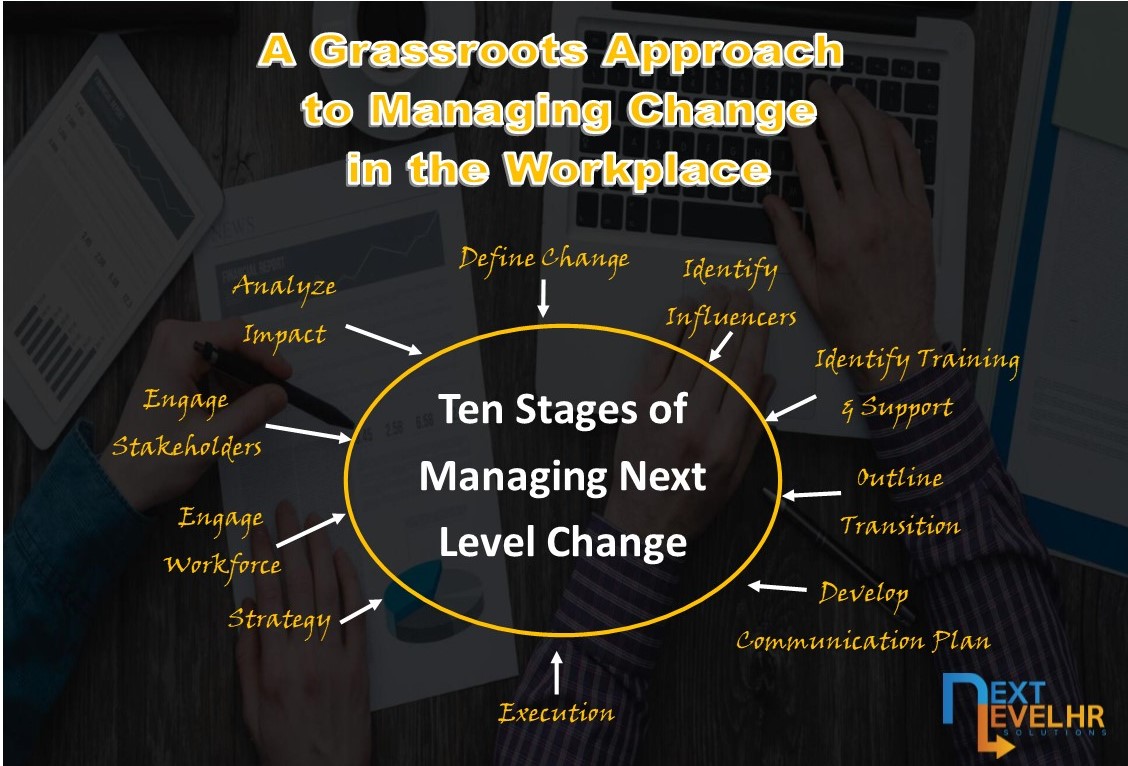A Grassroots Approach to Managing Change in the Workplace
- Posted on Feb 9, 2020

It ultimately happens. It’s unavoidable. It has to occur to execute a path for next level growth and success. Organizational CHANGE. Change affecting processes. Change affecting products. Change affecting people. Change resulting from federal mandates. With an understanding that change is inevitable, nothing can be more disruptive in the workplace than looming change. The typical employee’s reaction to change is resistance and fear. Fear of the unknown. Fear of the impact. Fear of mergers and acquisitions. Fear of downsizing. Fear of outsourcing. Fear of department restructuring/elimination. Fear of changes in management.
With a heightened focus on the team, collaboration, and inclusion, the reaction to change would seemingly lean more towards acceptance. But, the fact is employees in the workplace are feeling more alienated than ever. So, when the time for change comes, it’s critical that an organization has a grassroots approach to facilitate the communication and management of the change. Not just for employees, but also for stakeholders and others impacted by the change. Below is a fundamental overview of ten stages that organizations can use as a guide to successfully navigate through organizational change:
Define the Change: Define the change as soon as possible. What is changing? Why is it changing? How will it affect the work areas of employees? How will it affect employees directly? How will it impact workspaces and technology?
Analyze the Impact: Defining the change will assist with analyzing and clearly articulating the areas of the organization that will be affected, and the impact on stakeholders, employees, vendors/contractors, and customers.
Engage all stakeholders: Internal partners, such as departments or teams within an organization, or external partners like consultants, vendors/contractors, etc. should be included in the communication and management of change. The input they provide with respect to resources (additional or different resources) will be necessary for the change to have a successful outcome. The engagement of stakeholders and other impacted parties will also be necessary to gain their support of the change.
Engage all employees: Employees will have an abundance of questions, thoughts, concerns, and emotions. To engage all employees and actively listen to their concerns, address them, and provide assurance to them as openly and frankly as possible will help to facilitate the execution of change. Employees will know the organization appreciate their thoughts and input and seek to understand any concerns they may have with regards to the change. Because of honest conversations, employees are engaged and now feel involved in the process of the change. Employees are persuaded to support the change because they understand matters such as the “why” behind the change along with the benefits of the change.
Identify key influencers: Within every organization there are key players who have earned the trust and respect of their coworkers which has established them as key influencers. Engaging these key influencers to support the change and communicate their advocacy for the change will further help to navigate the execution of change.
Identify training and support needs: Change in an organizational may involve a focus on updating or adding new systems and procedures; launching new technologies; implementing new federal mandates; or improving, eliminating or rebranding products and services. Considerations must be given to employee training/retraining and/or the development necessary to prepare for and facilitate the change. For changes related to mergers and acquisitions, downsizing, outsourcing, department restructuring/elimination, etc. there will be a number of considerations related to the particular type of change being made.
Outline a transition plan: A transition plan will document all the activities and short-term requirements to implement the change. It provides a pivotal point for compiling, scheduling and managing all the tasks that will be required to transition from the old to the new.
Develop a Strategy: Developing a strategy for change is a key stage. The purpose of involving stakeholders, employees, etc. is for leaders to better understand and become knowledgeable about risks of the unknown, uncertainty, and any potential challenges. After everyone the change will impact has been provided an opportunity to share their thoughts, concerns, challenges – and risks have been fully identified and planned for – then it’s time to create a strategic plan to outline goals and objectives related to the execution of the change.
Develop a communication plan: Communicating change throughout the organization must be continuous during every stage of the change process (to include the goals/objectives, the “why”, the associated impact, and the benefits). Change must be repeated routinely with progress updates and include the opportunity for impacted parties to provide feedback. A great start for a successful communication plan is to develop personalized and targeted messages to reach impacted parties with only relevant and timely information. And, also create videos to publish that give stakeholders and employees the transparency, trust, and truth they require.
Execute the change: Simply execute the first step of your strategic plan and progress from there.
#ChangeManagement #OrganizationalChange #StrategicPlan #HR #HumanResoures #Strategic #Collaborative #Innovative #Progression #Grassroots #EffectiveCommunication #NextLevelHRSolutions #NextLevel

Great content! Super high-quality! Keep it up! 🙂
Thank you!